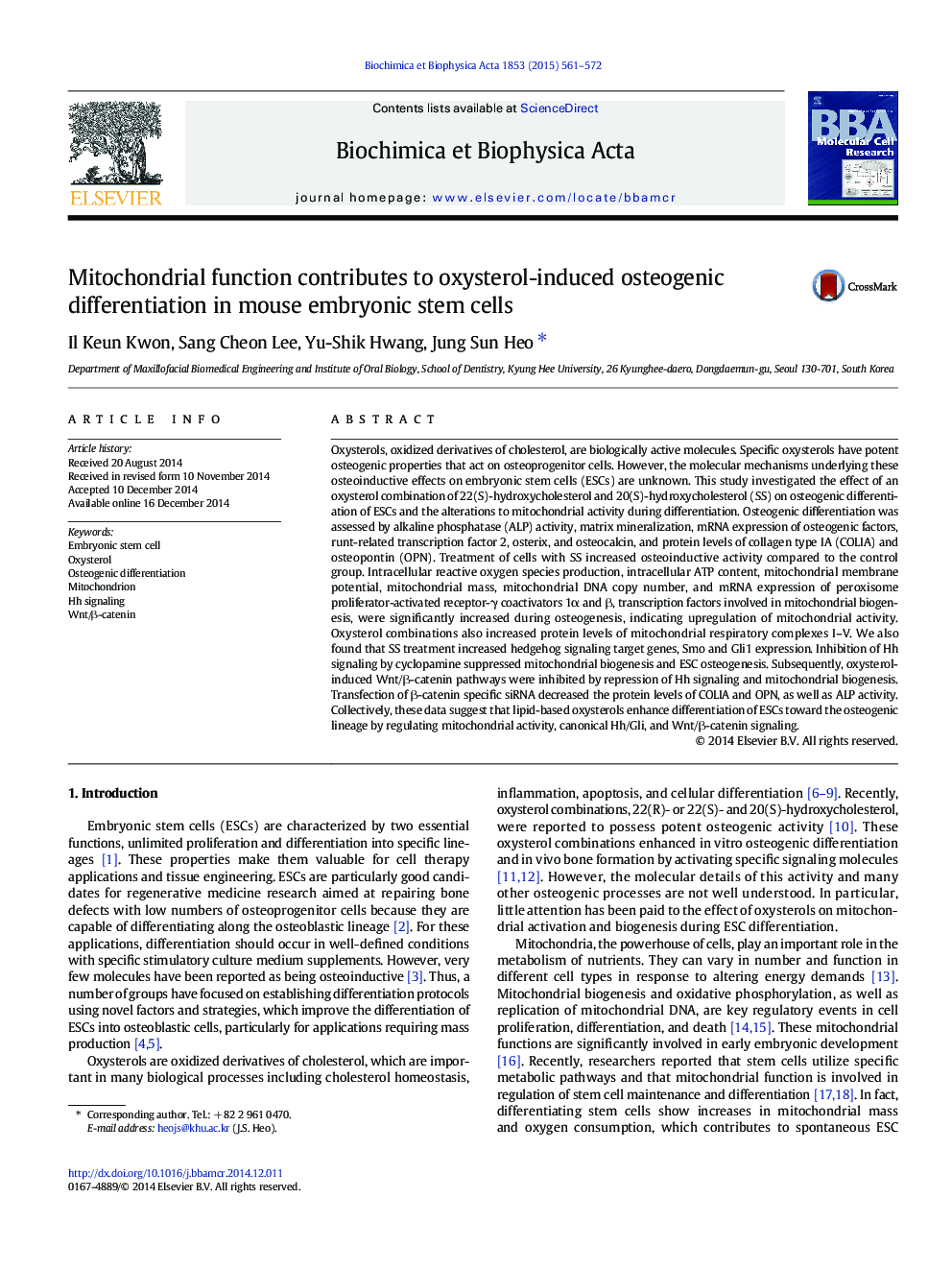| کد مقاله | کد نشریه | سال انتشار | مقاله انگلیسی | نسخه تمام متن |
|---|---|---|---|---|
| 10801974 | 1055650 | 2015 | 12 صفحه PDF | دانلود رایگان |
عنوان انگلیسی مقاله ISI
Mitochondrial function contributes to oxysterol-induced osteogenic differentiation in mouse embryonic stem cells
دانلود مقاله + سفارش ترجمه
دانلود مقاله ISI انگلیسی
رایگان برای ایرانیان
کلمات کلیدی
موضوعات مرتبط
علوم زیستی و بیوفناوری
بیوشیمی، ژنتیک و زیست شناسی مولکولی
زیست شیمی
پیش نمایش صفحه اول مقاله

چکیده انگلیسی
Oxysterols, oxidized derivatives of cholesterol, are biologically active molecules. Specific oxysterols have potent osteogenic properties that act on osteoprogenitor cells. However, the molecular mechanisms underlying these osteoinductive effects on embryonic stem cells (ESCs) are unknown. This study investigated the effect of an oxysterol combination of 22(S)-hydroxycholesterol and 20(S)-hydroxycholesterol (SS) on osteogenic differentiation of ESCs and the alterations to mitochondrial activity during differentiation. Osteogenic differentiation was assessed by alkaline phosphatase (ALP) activity, matrix mineralization, mRNA expression of osteogenic factors, runt-related transcription factor 2, osterix, and osteocalcin, and protein levels of collagen type IA (COLIA) and osteopontin (OPN). Treatment of cells with SS increased osteoinductive activity compared to the control group. Intracellular reactive oxygen species production, intracellular ATP content, mitochondrial membrane potential, mitochondrial mass, mitochondrial DNA copy number, and mRNA expression of peroxisome proliferator-activated receptor-γ coactivators 1α and β, transcription factors involved in mitochondrial biogenesis, were significantly increased during osteogenesis, indicating upregulation of mitochondrial activity. Oxysterol combinations also increased protein levels of mitochondrial respiratory complexes I-V. We also found that SS treatment increased hedgehog signaling target genes, Smo and Gli1 expression. Inhibition of Hh signaling by cyclopamine suppressed mitochondrial biogenesis and ESC osteogenesis. Subsequently, oxysterol-induced Wnt/β-catenin pathways were inhibited by repression of Hh signaling and mitochondrial biogenesis. Transfection of β-catenin specific siRNA decreased the protein levels of COLIA and OPN, as well as ALP activity. Collectively, these data suggest that lipid-based oxysterols enhance differentiation of ESCs toward the osteogenic lineage by regulating mitochondrial activity, canonical Hh/Gli, and Wnt/β-catenin signaling.
ناشر
Database: Elsevier - ScienceDirect (ساینس دایرکت)
Journal: Biochimica et Biophysica Acta (BBA) - Molecular Cell Research - Volume 1853, Issue 3, March 2015, Pages 561-572
Journal: Biochimica et Biophysica Acta (BBA) - Molecular Cell Research - Volume 1853, Issue 3, March 2015, Pages 561-572
نویسندگان
Il Keun Kwon, Sang Cheon Lee, Yu-Shik Hwang, Jung Sun Heo,